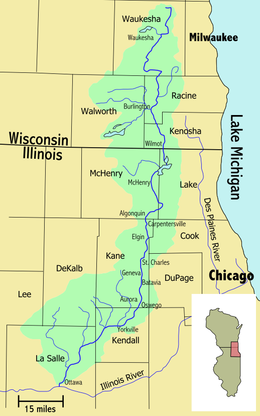Loading AI tools
Fox River (Illinois River tributary)
River in Illinois, United States From Wikipedia, the free encyclopedia
River in Illinois, United States From Wikipedia, the free encyclopedia
The Fox River is a 202-mile-long (325 km)[2] tributary of the Illinois River, flowing from southeastern Wisconsin to Ottawa, Illinois in the United States. The Wisconsin section was known as the Pishtaka River in the 19th century.[4] There is another Fox River in Wisconsin that flows through Lake Winnebago into Green Bay. There are also two other "Fox Rivers" in southern Illinois: the Fox River (Little Wabash tributary) and a smaller "Fox River" that joins the Wabash River near New Harmony, Indiana.
| Fox River | |
|---|---|
 The Fox River near South Elgin, Illinois | |
 Fox River and its watershed | |
| Location | |
| Country | United States |
| States | Wisconsin, Illinois |
| Physical characteristics | |
| Source | |
| • location | 1 mi (1.6 km) southeast of Colgate, Wisconsin |
| • coordinates | 43°11′09″N 88°11′42″W[1] |
| • elevation | 942.78 ft (287.36 m)[2] |
| Mouth | |
• location | Illinois River at Ottawa, Illinois |
• coordinates | 41°20′37″N 88°50′26″W[1] |
• elevation | 460.28 ft (140.29 m)[2] |
| Length | 202 mi (325 km) |
| Discharge | |
| • location | mouth |
| • average | 2,346.01 cu ft/s (66.432 m3/s) (estimate)[3] |
| Basin features | |
| Progression | Fox River → Illinois → Mississippi → Gulf of Mexico |
| River system | Mississippi River |
| Tributaries | |
| • left | Poplar Creek, Morgan Creek |
| • right | Nippersink Creek, Tyler Creek, Ferson Creek, Big Rock Creek, Indian Creek |
| Waterbodies | Chain O'Lakes |
The Fox River (Illinois River tributary) is known locally as an excellent fishery with opportunities for Smallmouth Bass, Flathead Catfish, and Walleye. The rivers watershed encompasses 1720 square miles in Illinois and 938 square miles in Wisconsin.

The Fox River rises in the Halbach Swamp,[5] 1 mi (1.6 km) southeast of the community of Colgate, Wisconsin[1] and flows past Brookfield, Waukesha, Big Bend, Waterford, Rochester, Burlington, Wheatland, Silver Lake and Wilmot, for a total of 84 miles (135 km)[2] in Wisconsin.
A major dam in Waterford forms a 1,200-acre (4.9 km2) navigable waterway which is one of the busiest in southeastern Wisconsin. The river is generally navigable from the Iron Bridge (now a concrete bridge) in Tichigan, Wisconsin (just south of Big Bend) down to the dam. The river connects several small lakes in this section, and one large lake, Tichigan Lake and one smaller lake, Buena Lake. The entire area including connected lakes and the Fox are often referred to as Tichigan Lake.
At the southern end of this section, Foxwood Isle separates the main dam to its west and a spillway to the east.
A small dam is present just a few miles south in downtown Rochester. The river then flows unobstructed through Burlington, where it joins the White River, and on to Wilmot. This is a popular and picturesque day-canoe trip never straying far from the road, but often just out of sight of it.
Flooding is common on this section of the river, especially near Wheatland to the border.
The Fox River watershed encompasses 938 square miles in Wisconsin.[6]



The river enters Illinois where it widens into a large area of interconnected lakes known as the Chain O'Lakes. Fox Lake is the largest village in this area. From the chain, the river flows generally southward for 118 miles (190 km),[2] until it joins the Illinois River at Ottawa. Illinois towns and communities that are on the Fox River include (from north to south): Fox Lake, Johnsburg, McHenry, Holiday Hills, Island Lake, Burtons Bridge, Port Barrington, Cary, Fox River Grove, Algonquin, Carpentersville, West Dundee, East Dundee, Elgin, South Elgin, St. Charles, Geneva, Batavia, North Aurora, Aurora, Montgomery, Oswego, Yorkville, Plano, Millington, Sheridan and Ottawa. Collectively, the area surrounding the Fox River is known as the Fox Valley. Around 1 million people live in this area.[7]
Native American tribes that lived near the Fox River included the Potawatomi, Sac, and Fox tribes.
The Fox River has 15 dams, including McHenry Dam, which raises the river slightly to maintain depth in the Chain O'Lakes in northern Illinois, the Montgomery Dam and the Dayton Dam, a hydroelectric dam near Ottawa. In September 2023, the United States Army Corps of Engineers issued a draft report[8] recommending the removal of nine of these dams for environmental reasons.
In the winter, bald eagles can be found nesting along the banks.
Early in the history of Illinois, the Fox River provided water for the Illinois and Michigan Canal via a feeder canal, allowing the canal to pass over the Fox River on an aqueduct.
The Fox River watershed encompasses 1720 square miles in Illinois.[6]
Seamless Wikipedia browsing. On steroids.
Every time you click a link to Wikipedia, Wiktionary or Wikiquote in your browser's search results, it will show the modern Wikiwand interface.
Wikiwand extension is a five stars, simple, with minimum permission required to keep your browsing private, safe and transparent.